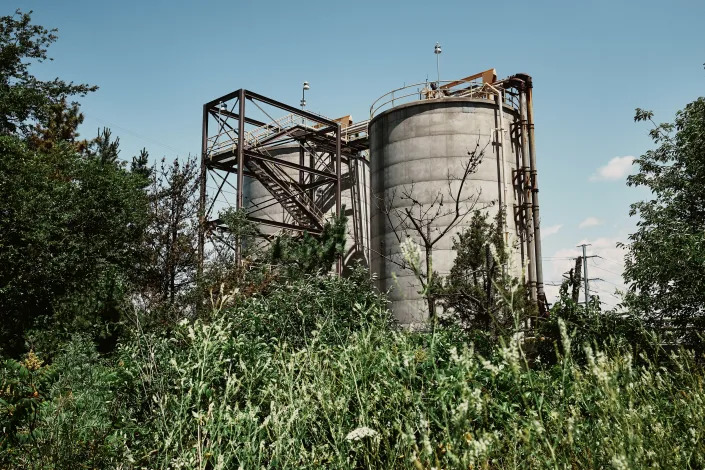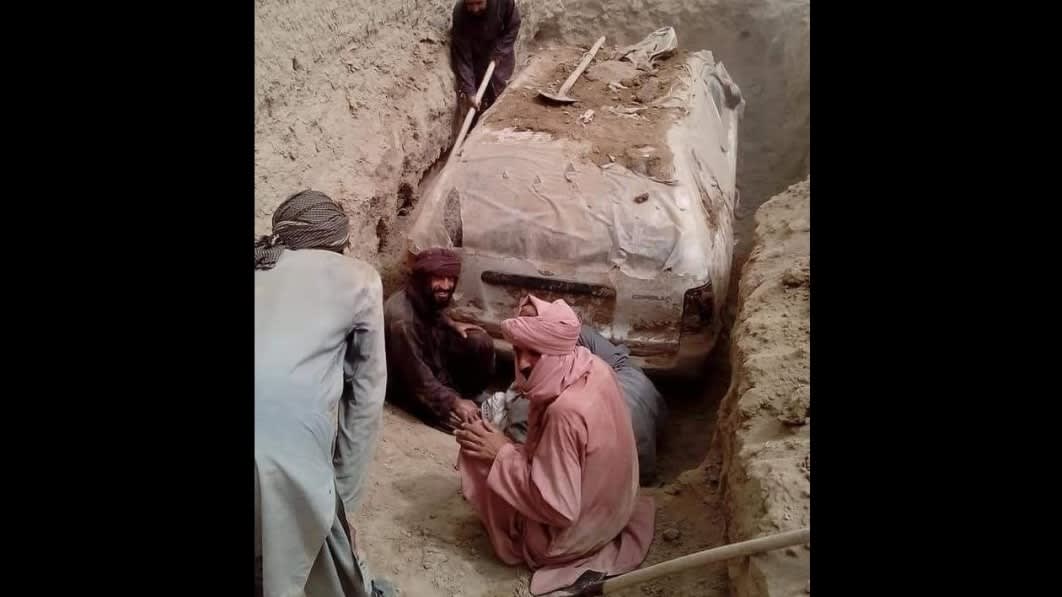Elena Shao
Fri, July 15, 2022

Silos of ash and other waste at the Brayton Point Power Station, a retired coal-fired power plant in Somerset, Mass., on July 7, 2022. (Simon Simard/The New York Times)
Across the country, aging and defunct coal-burning power plants are getting new lives as solar, battery and other renewable energy projects, partly because they have a decades-old feature that has become increasingly valuable: They are already wired into the power grid.
The miles of high-tension wires and towers often needed to connect power plants to customers far and wide can be costly, time-consuming and controversial to build from scratch. So solar and other projects are avoiding regulatory hassles and potentially speeding up the transition to renewable energy by plugging into the unused connections left behind as coal becomes uneconomical to keep burning.
In Illinois alone, at least nine coal-burning plants are on track to become solar farms and battery storage facilities in the next three years. Similar projects are taking shape in Nevada, New Mexico, Colorado, North Dakota, Nebraska, Minnesota and Maryland. In Massachusetts and New Jersey, two retired coal plants along the coast are being repurposed to connect offshore wind turbines to the regional electrical grids.
“A silver lining of having had all of these dirty power plants is that now we have fairly robust transmission lines in those places,” said Jack Darin, director of the Illinois chapter of the Sierra Club, an environmental advocacy group. “That’s a huge asset.”
Over the past two decades, more than 600 coal-burning generators totaling about 85 gigawatts of generating capacity have retired, according to the U.S. Energy Information Administration. (Individual power plants can have more than one generator.) A majority of the 266 remaining coal-burning power plants in the country were built in the 1970s and 1980s and are nearing the end of their approximately 50-year operational lifetime.
Most of that retired capacity will not be replaced with coal, as the industry gets squeezed out by cheaper renewable energy and tougher emissions regulations. At the same time, renewable energy producers are facing obstacles getting their projects connected to the grid. Building new power lines is costly and controversial, as neighbors often oppose transmission lines that can disturb scenic vistas or potentially reduce property values nearby. In addition, getting power line projects approved by regulators can be time-consuming.
Building and operating renewable energy projects has long been cheaper than fossil fuel plants. The barrier “is not economics anymore,” said Joseph Rand, a scientist at the Lawrence Berkeley National Laboratory, which conducts research on behalf of the U.S. Department of Energy. “The hardest part is securing the interconnection and transmission access.”
This makes old coal plants an attractive option as sites for renewable energy projects. Not only are the old plants already wired into the transmission system, they also have substations, which help convert electricity to a supply that is suitable for use in homes and businesses.
That was a key factor in choosing Brayton Point Power Station as a grid connection point for a 1,200-megawatt wind farm 37 miles off the coast of Massachusetts, said Michael Brown, CEO of the offshore wind developer Mayflower Wind.
At 1,600 megawatts, the coal-fired plant was the largest one in New England when it retired in 2017. The facility itself, located in the waterfront town of Somerset, will be replaced by an undersea-cable factory owned by the Italian company Prysmian Group. And the offshore wind project will connect to the grid at the Brayton Point interconnection point, making use of the existing substation there.
In one of the most ambitious efforts, Vistra Corp., a Texas-based power generation company that also owns a variety of power plants in California and Illinois, said it would spend $550 million to turn at least nine of its coal-burning facilities in Illinois into sites for solar panels and battery storage.
The largest, a plant in Baldwin, Illinois, that is set to retire by 2025, will get 190,000 solar panels on 500 acres of land. Together, the panels will generate 68 megawatts of power, enough to supply somewhere between 13,600 and 34,000 homes, depending on the time of year. It will also get a battery that can store up to 9 megawatts, which will help distribute electricity when demand peaks or the sun is not shining.
Vistra CEO Curtis Morgan said it became clear that the power company would need to “leave coal behind,” and it was eager to build new zero-emissions projects to replace some of the power from those plants. However, he said, the slow process of getting approval from grid operators, which coordinate and monitor electricity supplies, has been a roadblock for a number of Vistra’s proposed projects.
A surge in proposals for wind, solar and battery storage projects has overwhelmed regulators in recent years, according to an analysis from the Lawrence Berkeley National Laboratory, which overlooks the University of California’s Berkeley campus. In 2021, wait times had almost doubled from a decade before, to nearly four years, and that does not include the increasing number of projects that are withdrawing from the process entirely.
If every project currently waiting for approval gets built, “we could hit 80% clean energy by 2030,” said Rand, the lead author of the report. “But we’d be lucky if even a quarter of what’s proposed actually gets completed.”
Three of Vistra’s battery storage projects in Illinois — at the Havana, Joppa and Edwards coal plants — also benefited from an infusion of grants from a state law, the Climate and Equitable Jobs Act, aimed at supporting a “just transition” for coal-dependent communities toward renewable energy. It was signed by Gov. J.B. Pritzker last fall and also required all fossil-fuel-burning plants to cut their emissions to zero by 2045, which could lead to their closure, though most of the coal plants in Illinois were already poised to shut down within a decade.
The Coal-to-Solar Energy Storage Grant Program that emerged from the legislation also supports two other battery projects, owned by NRG Energy, which will be built at the Waukegan and Will County coal-burning power stations.
The advantage of building renewable energy projects on old coal plants is twofold, said Sylvia Garcia, director of the Illinois Department of Commerce and Economic Opportunity, which oversees the coal-to-solar program. First, projects benefit from the ease of reusing an existing connection to the grid. Second, it is an effort toward “trying to reinvest in the communities that have lost those coal plants” in the first place, she said.
While the new projects will temporarily create construction jobs, operating a solar plant or battery facility usually does not require as many employees. The Baldwin plant previously employed around 105 full-time workers. And while Vistra has not yet finalized numbers on a site-by-site basis, the nine Illinois projects combined will create 29 full-time jobs annually, the company’s communications director, Meranda Cohn, said in an email.
Coal plants also typically sit on a sizable parcel of land, and redeveloping those sites into renewable energy projects is a way to put something productive on a piece of property that might otherwise go unused.
“It’s really shifting a very negative resource into one that is more positive for the community,” said Jeff Bishop, CEO of Key Capture Energy, which plans to locate a 20-megawatt battery storage project at a retired coal plant near Baltimore.
Elsewhere in Holyoke, Massachusetts, the retirement of Mount Tom Station, a coal plant that had operated for more than five decades, presented a number of possibilities, said Julie Vitek, vice president of government and regulatory affairs for the power producer ENGIE North America. After meetings with government officials, environmental groups and residents, a solar farm emerged as the best way to “give new life to the industrial land at Mount Tom,” she said.
Today, the property is home to some 17,000 solar panels and a small battery installation that form a community solar project managed by Holyoke Gas & Electric, a city-owned utility that gives customers the choice to opt in to receiving solar power from the project. The panels produce about 6 megawatts of power, enough to power about 1,800 homes.
It is not only solar, battery and wind developers that are eyeing old coal plants for their infrastructure. TerraPower, a nuclear power venture founded by Bill Gates, is locating a 345-megawatt advanced nuclear reactor adjacent to a retiring coal plant in Kemmerer, Wyoming. The location will not only allow the reactor to take advantage of the existing grid connection but also to make use of the coal plant’s cooling system, said Chris Levesque, TerraPower’s president and CEO.
“In a way, it’d be a real shame not to make use of those coal plants,” Levesque said.
© 2022 The New York Times Company


















